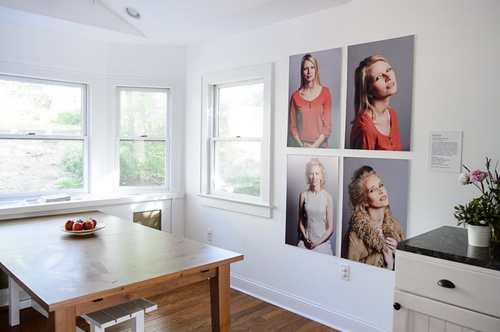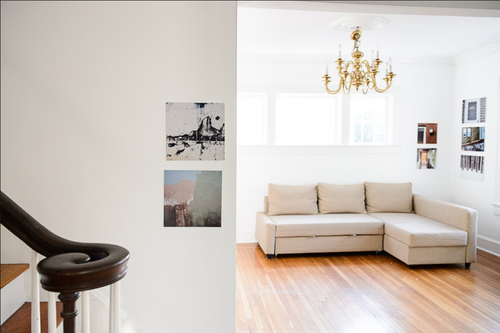by guest blogger Peter Dunn
Use this straightforward three-step process when planning your next exhibition for art fairs, open studios, or in your home.

Figure 1. A portrait quartet makes a powerful impression at an open studio. Photo by Ananda Lima.
Showing your work to an audience is, in many ways, the culmination of the creative process. It provides a prime chance for people to discover and fall in love with your work. Here’s a three-step process you can use to plan your next showing so that it generates the most interest and engagement and draws people into your creative world.
Step 1: Consider the People and the Place
Start by considering who will be looking at your display, and the environment they’ll be in. Ask yourself:
- Is the display just for friends and family, or a broader group?
- Will the venue be busy? Quiet? Formal? Casual?
- Will people primarily be there to look at art, or for some other reason?
- Will other exhibits and/or activities be competing for attention?
This information will help you craft a display strategy that supports your artistic mission in that specific time and place.
That mission is the same one faced in any art display, whether in a living room or a grand museum: catch the viewer’s eye with a strong, intriguing visual statement that draws them in, and engage their mind with additional pieces that flesh out the story you’re striving to tell.
Ideally, spend time in the display space and pretend to arrive as a newcomer would. Where is your eye first drawn? What distractions need to be overcome? What path do your steps instinctively follow?
Step 2: Create a Strong First Impression
The most important decision is the choice of a “first impression” piece. It should be strong, clear, and highly representative of your style, so it can hold down the most prominent spot and serve as your eye-catching billboard.
Your survey of the venue should help you pinpoint the best place for this piece, whether it’s at the entrance to your open studio, in a high-visibility spot at an art fair, or on a wall in your home seen by arriving visitors.
The first order of business is creating an initial moment of intrigue that leads to a deeper connection. Do what museums do for special shows: distinguish your first-impression piece with a neutral background, ample empty space, and good lighting. A title card or short caption can help. If the venue will be crowded, hang the piece higher than you might otherwise.
Sometimes groups of related works can have extra punch. Photographer Ananda Lima created the engaging quartet of portraits above in Figure 1 for an open studio exhibition at her home. Any of the four images would be striking, but together they present multiple aspects of a person in a very eye-catching way.

Figure 2. Jewel-like images invite viewers into the next room. Photo by Ananda Lima.
Step 3: Cultivate the Connection
Give viewers at least one obvious “next step” for further engagement. The exact approach will vary, but one or more of your strongest supporting pieces should be visible to someone looking at the first-impression display.
Figure 2, another example from Ananda Lima, illustrates one approach to this. The two small images in the foreground engage people in the entryway, while the intriguing corner group beyond invites them into the next room.
If you have enough adjacent space on the same wall, you can try flanking the central work or works (at a respectful distance) with supporting pieces. The follow-on pieces can also go on an adjacent wall, or even in a separate area, as long as there’s an obvious visual connection. They can offer a contrast or comparison, or open a whole new line of thought, as long as they continue the engagement process.
A few other points:
- Overcrowding is a common problem. Winnow things down and leave space so each piece stands out.
- Be careful with long uniform rows, as they can blur together. Instead, cluster related pieces and leave space between.
- Not everything has to go on the wall. Supplement displayed works with nearby portfolios, bins, or boxes for visitors to browse through. You can even provide a chair and a few non-messy snacks; this level of connection is a victory.
This guidance is excerpted from Everyone’s Guide to Art Hanging, a new e-book that compiles extensive practical advice from art professionals and artists. Get your free copy here.
Peter Dunn is marketing director for Gallery System Art Displays, a supplier of art hanging systems to galleries and other venues. The son and husband of artists, his display experience includes residential and professional settings.


Speak Your Mind